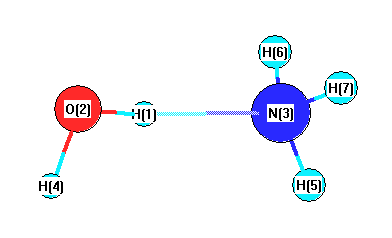Vibrational Frequencies calculated at HF/6-31G*
| Mode Number |
Symmetry |
Frequency
(cm-1) |
Scaled Frequency
(cm-1) |
IR Intensities
(km mol-1) |
Raman Act
(Å4/u) |
Dep P |
Dep U |
|---|
| 1 |
A' |
4150 |
3729 |
82.53 |
|
|
|
| 2 |
A' |
3967 |
3565 |
316.16 |
|
|
|
| 3 |
A' |
3824 |
3436 |
5.14 |
|
|
|
| 4 |
A' |
3692 |
3317 |
3.59 |
|
|
|
| 5 |
A' |
1868 |
1678 |
94.50 |
|
|
|
| 6 |
A' |
1847 |
1659 |
34.05 |
|
|
|
| 7 |
A' |
1253 |
1126 |
204.87 |
|
|
|
| 8 |
A' |
425 |
382 |
124.70 |
|
|
|
| 9 |
A' |
185 |
166 |
19.89 |
|
|
|
| 10 |
A' |
161 |
145 |
46.15 |
|
|
|
| 11 |
A" |
3824 |
3436 |
6.11 |
|
|
|
| 12 |
A" |
1844 |
1656 |
25.10 |
|
|
|
| 13 |
A" |
673 |
605 |
246.16 |
|
|
|
| 14 |
A" |
158 |
142 |
42.18 |
|
|
|
| 15 |
A" |
19 |
17 |
85.49 |
|
|
|
Unscaled Zero Point Vibrational Energy (zpe) 13944.7 cm
-1
Scaled (by 0.8985) Zero Point Vibrational Energy (zpe) 12529.3 cm
-1
See section
III.C.1 List or set vibrational scaling factors
to change the scale factors used here.
See section
III.C.2
Calculate a vibrational scaling factor for a given set of molecules
to determine the least squares best scaling factor.
Charges, Dipole, Quadrupole and Polarizability
Charges from optimized geometry at HF/6-31G*
Charges (e)
| Number |
Element |
Mulliken |
CHELPG |
AIM |
ESP |
| 1 |
H |
0.495 |
|
|
|
| 2 |
O |
-0.934 |
|
|
|
| 3 |
N |
-1.029 |
|
|
|
| 4 |
H |
0.416 |
|
|
|
| 5 |
H |
0.348 |
|
|
|
| 6 |
H |
0.352 |
|
|
|
| 7 |
H |
0.352 |
|
|
|
Electric dipole moments
Electric dipole components in Debye
(What's a Debye? See section
VII.A.3)
| |
x |
y |
z |
Total |
| |
1.332 |
-3.765 |
0.000 |
3.993 |
| CHELPG |
|
|
|
|
| AIM |
|
|
|
|
| ESP |
|
|
|
|
Electric Quadrupole moment
Quadrupole components in D Å
| Primitive |
|---|
| | x | y | z |
|---|
| x |
-11.287 |
3.728 |
-0.018 |
| y |
3.728 |
-11.965 |
-0.035 |
| z |
-0.018 |
-0.035 |
-13.196 |
|
| Traceless |
|---|
| | x | y | z |
|---|
| x |
1.293 |
3.728 |
-0.018 |
| y |
3.728 |
0.277 |
-0.035 |
| z |
-0.018 |
-0.035 |
-1.570 |
|
| Polar |
|---|
| 3z2-r2 | -3.140 |
|---|
| x2-y2 | 0.678 |
|---|
| xy | 3.728 |
|---|
| xz | -0.018 |
|---|
| yz | -0.035 |
|---|
|
Polarizabilities
Components of the polarizability tensor.
Units are
Å
3 (Angstrom cubed)
Change units.
| |
x |
y |
z |
| x |
2.064 |
0.076 |
-0.004 |
| y |
0.076 |
2.233 |
-0.001 |
| z |
-0.004 |
-0.001 |
1.685 |
<r2> (average value of r
2) Å
2
| <r2> |
59.689 |
| (<r2>)1/2 |
7.726 |
